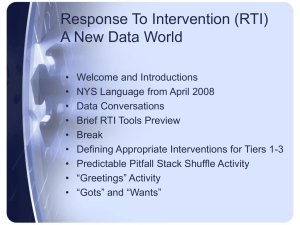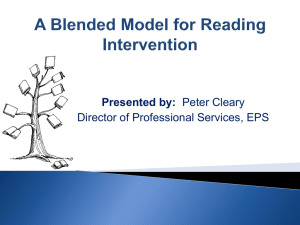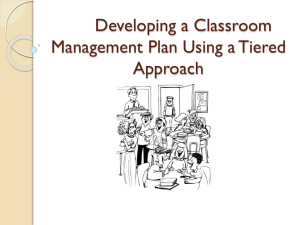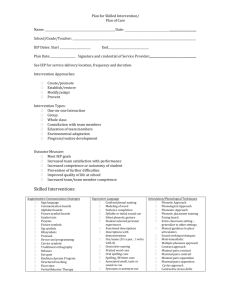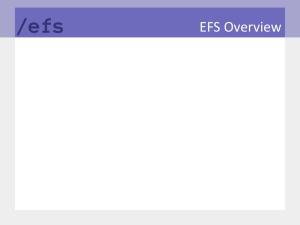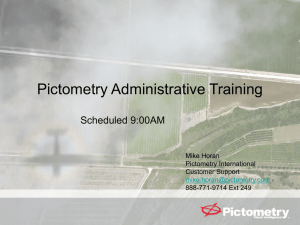ADHD
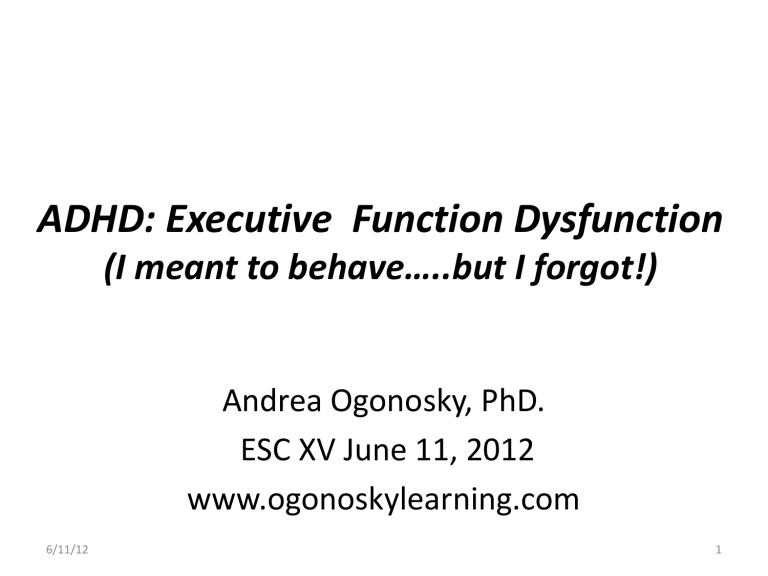
ADHD: Executive Function Dysfunction
(I meant to behave…..but I forgot!)
Andrea Ogonosky, PhD.
ESC XV June 11, 2012 www.ogonoskylearning.com
6/11/12 1
Core Symptoms
• Poor sustained attention (inattention, distractibility)
• Impulsivity (behavioral inhibition)
• Hyperactivity
6/11/12 2
Co-morbid Conditions
Psychiatric Disorders
• Oppositional Defiant Disorder (ODD)
• Conduct Disorder
• Antisocial/Delinquency
• Anxiety Disorders
• Major Depression
• Somatization Disorder
6/11/12 3
Associated Problems (School)
• Lagging in intellectual development over time
(10-15 points)
• Underperforming in school
• Excessive variability in work produced
• Low average achievement
• Learning disabilities (25-35%)
6/11/12 4
Associated Problems (Emotional)
• Poor rule-governed behavior
• Immaturity
• Irritable, hostile, excitable
• Hyper-responsiveness toward others
• Low frustration tolerance
• Demoralization
• Dysthymia
6/11/12 5
Associated Problems (Social)
• Increased parent/child conflicts
• Selfish/self-centered
• More interpersonal problems
• Peer rejection due to intrusive behavior(s)
• Little regard for social consequences
• Immature play
• Fewer close friendships
• Shorter duration of dating
6/11/12 6
Associated Problems (Medical)
• More allergies, colds, otitis
• Enuresis (43%)
• Increased minor injuries due to accidents
• Motor coordination problems (affects handwriting)
• Sleep disturbances
6/11/12 7
ADHD and Self-Control
• Behavioral Inhibition (Barkley et al.)
• Behavioral control shifts from external to internal
• Greater motor control
• Behavior focuses on time and future
6/11/12 8
Executive Functions
• Directive capacities of the mind
• Multiple in nature, not a single capacity
• Cue the use of other mental abilities
• Direct and control perceptions, thoughts, actions, and to some degree emotions
• Part of neural circuits that are routed through the frontal lobes
6/11/12 9
Executive Functions
Frequently referred to as “the CEO of the
Brain” or the “Conductor of the Orchestra
Better to think of Executive Functions as:
A Team of Conductors and Co-Conductors of a Mental
Ability Orchestra or …
The Coaching Staff of a Mental Ability Football Team
6/11/12 10
Executive Functions
• Direct and control perceptions, thoughts, actions, and to some degree emotions
• Part of neural circuits that are routed through the frontal lobes
6/11/12 11
Executive functions
Diverse group of cognitive processes
Acts in a coordinated way to direct perception, emotion, thought and action
Set of multiple cognitive capacities
Act in a coordinated way to engage in purposeful, organized, strategic, selfregulated, goal-directed behavior.
6/11/12 12
Development of EF
• Self-regulation executive functions are developing from the first years of life well into adulthood, and possibly throughout a person’s entire lifetime.
• Large developmental shifts are noticeable, especially around a adolescence.
• Because EFs are developmental in nature, natural maturational delays and lags are observed.
6/11/12 13
Development of EF
• All EFs do not develop evenly. For any given individual, one EF can be more or less developed than any other EF at any given point in time.
• There is also great variation relative to chronological age. At the same age, different individuals will naturally vary considerably in their level of development of various EFs.
6/11/12 14
6/11/12
Development of EF
Some EF-based clinical syndromes, such as
ADHD, demonstrate clear patterns of delayed developmental progression. Barkley (1998) estimates developmental delays of about 30% associated with various EF processes such as
Inhibit, Manipulate, Shift, Sustain, Time,
Monitor, Correct.
15
Executive Functions are involved with cueing and directing :
• Inhibiting impulsive responding;
• Stopping, or interrupting, and returning to, an ongoing activity;
• Directing and focusing attention, screening out interference and distractions, and sustaining attention
6/11/12 16
Executive Functions are involved with cueing and directing :
• The initiation of effort
• Judging about the amount of effort required to complete a task ….
Sustaining of a sufficient amount of effort to effectively complete the task
6/11/12 17
Executive Functions
• Shifts cognitive resources to focus on new demands , new conditions or new information
• Directs the efficient use of pattern and detail processing :
– Knowing when to focus on the “big picture”, when to concentrate on the details, and when to switch between the two).
• Monitors and regulates speed of information processing
6/11/12 18
Executive Functions
• Monitors and corrects task performance for accuracy and efficiency
• Oversees the selection of verbal-nonverbal and abstract-concrete processing mechanisms
• Directs motor output
• Directs the ability to mentally manipulate information (working memory)
• Directs the integration of multiple abilities to produce oral or written responses
6/11/12 19
Executive Functions
• Direct the efficient placement of information in long-term storage
• Direct the retrieval of information from longterm storage
• Regulates social behavior
• Regulates emotional control
• Enables self-observation and self-analysis
• Makes use of hindsight and foresight
• Enables the capacity to “take the perspective of the other”
6/11/12 20
Executive Functions and School
Acquiring Knowledge Demonstrating Knowledge
Many new learning situations are structured in ways that reduce the need for strong executive direction
Requires significant involvement of executive control processes.
Because executive control is heavily involved in demonstrating learning, executive difficulties usually manifest as “Producing Disabilities” much more so than “Learning Disabilities.”
6/11/12 21
Learning Difficulties and Producing
Difficulties
Learning Difficulties Only Often NOT recognized as a Learning Disability, even when severe
Learning Difficulties
And
Producing Difficulties
Producing Difficulties Only
Recognized as a
Learning Disability most of the time
When severe, typically attributed to motivation or personality problems
6/11/12 22
Impact of EF and Learning
• Although executive functions are used to guide cognitive processing involved in new learning, many new learning situations are structured in ways that reduce the need for strong executive direction.
• In direct contrast, demonstrating what has been learned usually requires significant involvement of executive control processes
6/11/12 23
6/11/12
Nonverbal Working Memory
– Imitation and vicarious learning
– Anticipation and preparation to act
– Awareness of self across time
– Spatial location
– Organization & reproduction of complex designs
– Less proficient at imitating sequences of simple motor gestures
– Psychological awareness of time
24
Verbal Working Memory
• Internalization of speech
– self-description and self-reflection
– rule governed behavior (self-instruction)
– digit span
– mental computation
– the basis for verbal thought
– memory tasks
– hindsight, forethought, and planning
6/11/12 25
6/11/12
EF and School
Test taking can be exceptionally difficult for a student with executive difficulties if the test format emphasizes executive demands over content knowledge.
26
6/11/12
EF and School
In the classroom, the task most frequently impacted by executive function-driven producing difficulties is written expression.
27
EF and Written Language
• Poor grapho-motor control and lack of automaticity for handwriting.
• Poor organization of written material
• Poor retrieval cueing or poor generate cueing for idea generation or idea fluency when writing.
• Inability to use multiple self-regulation
• EFs at one time (e.g. hold, manipulate, retrieve with generate and execute).
6/11/12 28
Reading and EF
• Reading Decoding – poor use of one or more self-regulation EFs (e.g., lack of attention to specific letters in words; saying words that
“look” like the word on the page).
• Rapid Automatic Naming – poor executive control of language fluency processes.
• Reading Comprehension – poor direction of one or more self-regulation EFs (e.g., Focus,
Sustain, Hold, Manipulate, Balance, Pace,
29
Math and EF
• Poor cueing of Focus/Select, Monitor, and
Correct functions when doing calculation routines.
• Poor cueing of hold, organize, manipulate and retrieve when setting up calculations or problems
• Poor cueing of organize, store, retrieve, execute when learning or applying rote knowledge (e.g. storing and retrieving multiplication tables).
6/11/12 30
Interventions
General Two-Stage Approach to Intervention:
1. Attempt to Affect Internal Change
2. Apply External Control As Necessary
6/11/12 31
Important Life Changes That Work!
(Hallowell, 2005)
• Positive human contact
• Reduce electronics
• Sleep (increase opportunities)
• Diet: balanced - eat protein at breakfast
• Exercise
• Prayer or meditation
6/11/12 32
Implications for Interventions
• Intervene at “points of performance”
• Externalize all information
• Externalize sources of motivation
• Arrange immediate consequences for task initiation and completion
• Plan to provide interventions over the longterm
6/11/12 33
6/11/12
Tier 1: Core Foundations
Build a Culture of Acceptance and Safety
High performance expectations for all students
Clearly articulated rules and consequences
Strong student teacher relationships
High level of parent and student participation
Student connectedness to the school process
Multiple opportunities for success with academic and social skill development
Conflict resolution strategies actively taught and modeled (school-wide)
34
6/11/12
Building Internal Strategies
Providing students with feedback about their performance enables them to engage executive capacities more effectively to learn from their mistakes and improve future performance
35
Build Internal Strategies
• Use IES guides to develop strategy instruction within Tiered interventions.
• Align anchor activities within instructional groups for repeated practice of strategy use within intervention.
6/11/12 36
6/11/12
Classroom Instruction (TIER 1)
To assure that executive function capacities are used to their fullest potential, it is important to state the goals of the learning process. Stating goals enables executive capacities, either consciously or nonconsciously, to engage the perceptions, emotions, thoughts, and actions, needed to achieve the goals.
37
Tier 1
• In many ways, teachers ARE their student ‘s frontal lobes.
• Providing prompts and cues are important to assure that children are engaged appropriately in the instructional process.
• Modeling good executive functions helps children see how they can self-regulate their own perceptions, emotions, thoughts and actions.
6/11/12 38
Homework: 7 Skills Parents Can Help
Children Learn
• Insure assignments are copied correctly and get home with proper books/materials
• Select work place at home
• Start assignments by reading directions and following them carefully
• Manages difficult or long-term assignments
6/11/12 39
Homework: 7 Skills Parents Can Help
Children Learn
• Maintains attention to boring tasks
• Checks work for accuracy and completeness
• Gets homework to school when done
6/11/12 40
Homework (Parental Responsibility)
• Create Proper homework environment
– Quiet place
– Regular schedule
– Necessary supplies
• Teachers instructions and requirements are understood
• Awareness of child’s difficulties-inform teacher
6/11/12 41
Homework (Parental Responsibility)
• Set homework goals-reinforce achievement
• Motivation: praise, self-monitoring
• Organize assignments
6/11/12 42
STRIVE FOR FIVE!
• Strong Positive Behavior Supports: Schoolwide, classroom, individual
• Highly structured classroom
6/11/12 43
6/11/12
Foster Positive Teacher Student
Relationships
Pair and Share
44
Classroom Strategies
(Self-Discipline)
• Adopt classroom management and disciplinary practices that are proactive, instructive, and corrective
• Correct behavior fairly and consistently
• Arrange physical environment to reduce congestion and facilitate smooth and quiet movement of students
6/11/12 45
Classroom Strategies
(Self-Discipline)
• Use a variety of teaching methods to address various learning styles
• Review and discuss acceptable behavior expectations throughout the year
• Reinforce positive behaviors
6/11/12 46
Characteristics of a Positive
Classroom Environment
Create a welcome and inviting atmosphere:
• Free from clutter
• Highly organized
• Daily routines established
• Rules visible and reinforced daily
6/11/12 47
6/11/12
How do you arrange a classroom to increase academic engagement?
48
Physical Arrangement of Classroom
• Divide room into logical work areas:
– All students can be easily seen by teacher
– Maximize student personal space by arrangement of desks
– Establish traffic patterns
– Minimize areas of distractions
– Maintain distance between students and supply/storage areas
6/11/12 49
Principles for Managing EF
• Externalize time, reduce delays
• Externalize important information
• Externalize motivation
• Externalize problem solving (chore cards)
• Immediate feedback
• Increased frequency of consequences
6/11/12 50
Principles for Managing EF
• Increase accountability of others
• Use more salient and artificial rewards
• Change rewards periodically
• Touch more, talk less
• Act, don’t Yak
• Keep sense of humor
6/11/12 51
Principals for Managing EF
• Use positives before negatives
• Anticipate problems; have a plan
• Maintain a sense of priorities
• Practice forgiveness (child, self, others)
6/11/12 52
Command Effectiveness
Use imperatives, not questions
Break down complex tasks to simpler ones
Bridge time delays in tasks (use external cues to bridge tasks)
Use single-step commands
Praise initiation of compliance and reinforce throughout task
Get attention before giving directions
6/11/12 53
6/11/12
Tier 2 Strategic Interventions
54
Conduct Functional Behavior
Assessment
• Tier 2: Informal data gathered through observations, consultations, review of teacher data and student products
• Purpose:
6/11/12
– To identify the function(s) maintaining problem behaviors
• antecedent events = triggers occurrence of behaviors
• consequences = maintains behavior episodes
55
Tier 2: Common Principles of Strategic
Interventions
• Positive Behavior Supports are used to motivate students.
• Corrective feedback is immediate.
• Students master content before moving on to more difficult activities.
• Professionals are trained to implement intervention with high level of fidelity:
– Practice with all staff to ensure consistency
– Meet weekly to problem solve and share ideas
6/11/12 56
Tier 2: Behavior Reduction Strategies to Monitor
• Responding to misbehavior
– Continuum of consequences established
– Consider misbehavior as a behavioral error: treat like an academic skills error
– Re-teach appropriate behavior
– Respond consistently and efficiently
– Observe the effects of behavior reduction strategy
• Punishment??? Behavior increases??
6/11/12
– Respond early: avoid escalation, prolonged existence 57
RtI Team Roles in Tier 2
• Ongoing progress monitoring of data
(specifically ensuring fidelity of data collection)
• Social Skills Training
• Motivational Strategies
6/11/12 58
Targeted Group Interventions
ADHD
• Small group instruction within the areas of self-monitoring for problem solving, social skills, behavioral regulation
• Small group instruction for identified academic deficits.
6/11/12 59
Tier 3 Team Role: Intervention
Implementation
• Assist with intervention
• Fidelity checks at least weekly
• Revise when needed regarding fidelity
• Monitor progress
• Design and implement
• Provide feedback to teacher or parent
6/11/12 60
Tier 3 Interventions
Prevention (Make problem behaviors irrelevant):
• Schedule
• Curriculum (content, sequence)
• Instruction
• Skill Building (Teach desired behaviors)
• Teaching = delivering events that change behavior, not just delivering curriculum
• Replacement behaviors (maintain same function as problem behavior)
• Adaptive skills
6/11/12 61
Increase Behavioral Successes
Find the buried Treasures (Hallowell, 2005)
1. Connect
2. Play
3. Practice
4. Master
5. Recognition
6/11/12 62
6/11/12
Determining Eligibility for OHI
• Full and individual evaluation that is comprehensive
• Meet three prongs
▫ Eligible according to disability classification criteria
▫ Eligible due to adverse impact of disability on attainment of an appropriate education (using RtI data collection)
▫ Eligible due to need for special education (specially designed instruction and related services)
63
Questions
Thank you for staying on task and engaged to a marked degree and for a long period of time!
6/11/12 64


